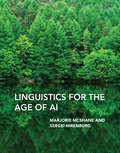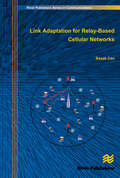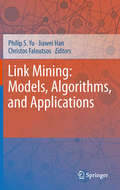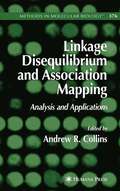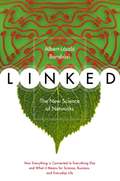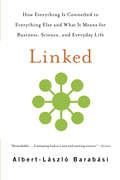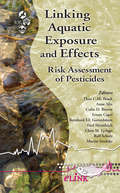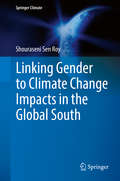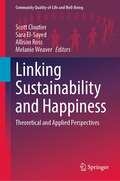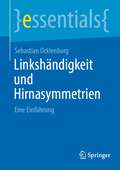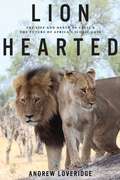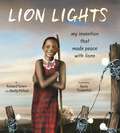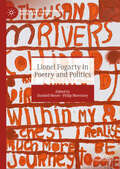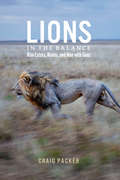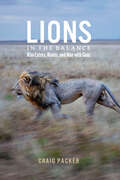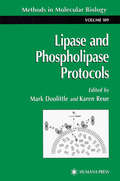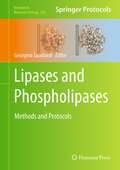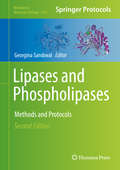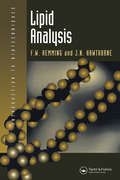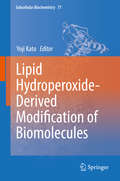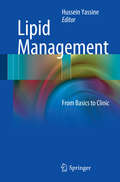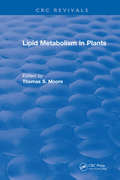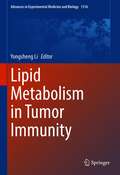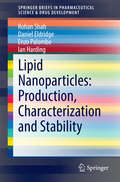- Table View
- List View
Linguistics for the Age of AI
by Sergei Nirenburg Marjorie McshaneA human-inspired, linguistically sophisticated model of language understanding for intelligent agent systems.One of the original goals of artificial intelligence research was to endow intelligent agents with human-level natural language capabilities. Recent AI research, however, has focused on applying statistical and machine learning approaches to big data rather than attempting to model what people do and how they do it. In this book, Marjorie McShane and Sergei Nirenburg return to the original goal of recreating human-level intelligence in a machine. They present a human-inspired, linguistically sophisticated model of language understanding for intelligent agent systems that emphasizes meaning--the deep, context-sensitive meaning that a person derives from spoken or written language.
Link Adaptation for Relay-Based Cellular Networks
by Basak CanCover TextLink Adaptation for Relay-Based Cellular Networks focuses on the implementation of various link adaptation methods in OFDM(A) (Orthogonal Frequency Division Multiplexing/Multiple Access)?Time Division Duplex (TDD) based two-hop cellular networks. The analysis and design consider infrastructure based relays. New link adaptive transmission methods which dynamically select the channel coding, modulation, forwarding, relaying mechanisms and the packet size have been designed and evaluated for such networks. The selection among various schemes is based on maximizing the end-to-end throughput.This book provides a channel adaptive scheduler which considers the multiplexing loss caused by the two-phase nature of wireless relaying. The scheduler dynamically schedules the users on the frequency-time radio resources with efficient Modulation and Coding Schemes (MCS)s selected by Adaptive Modulation and Coding (AMC). Relaying is used only if it can provide throughput enhancement. The guidelines for efficient deployment of infrastructure based relay terminals are given. For the two-hop cellular communication systems, the system level performance of various cooperative diversity schemes has been investigated with the scheduler developed and the relays efficiently deployed in the cell. This investigation for low mobility scenarios shows that, a simple cooperative diversity scheme that dynamically chooses the best scheme among direct transmission and two-hop conventional relaying is a promising choice when compared to various more complex cooperative diversity schemes.In this book, a hop adaptive Medium Access Control (MAC)-Protocol Data Unit (PDU) size optimization is proposed for wireless relay networks.
Link Mining: Models, Algorithms, and Applications
by Jiawei Han Christos Faloutsos Philip S. YuThis book presents in-depth surveys and systematic discussions on models, algorithms and applications for link mining. Link mining is an important field of data mining. Traditional data mining focuses on "flat" data in which each data object is represented as a fixed-length attribute vector. However, many real-world data sets are much richer in structure, involving objects of multiple types that are related to each other. Hence, recently link mining has become an emerging field of data mining, which has a high impact in various important applications such as text mining, social network analysis, collaborative filtering, and bioinformatics. At present, there are no books in the market focusing on the theory and techniques as well as the related applications for link mining. On the other hand, due to the high popularity of linkage data, extensive applications ranging from governmental organizations to commercial businesses to people's daily life call for exploring the techniques of mining linkage data; people need such a reference book to systematically apply the link mining techniques to these applications to develop the related technologies. Therefore, such a book is in high demand on the market.
Linkage Disequilibrium and Association Mapping
by Andrew R. CollinsAs researchers continue to make enormous progress in mapping disease genes, exciting, novel, and complex analyses have emerged. In this book, scientists from around the world, who are leaders in this field, contribute their vast experience and expertise to produce a comprehensive and fascinating text for researchers and clinicians alike. They provide cutting-edge analysis of the most up-to-date and preeminent information available.
Linked
by Albert-Laszlo Barabasi Jennifer FrangosIn the 1980's, James Gleick's Chaos introduced the world to complexity. Now, Albert-László Barabási's Linked reveals the next major scientific leap: the study of networks. We've long suspected that we live in a small world, where everything is connected to everything else. Indeed, networks are pervasive--from the human brain to the Internet to the economy to our group of friends. These linkages, it turns out, aren't random. All networks, to the great surprise of scientists, have an underlying order and follow simple laws. Understanding the structure and behavior of these networks will help us do some amazing things, from designing the optimal organization of a firm to stopping a disease outbreak before it spreads catastrophically. In Linked, Barabási, a physicist whose work has revolutionized the study of networks, traces the development of this rapidly unfolding science and introduces us to the scientists carrying out this pioneering work. These "new cartographers" are mapping networks in a wide range of scientific disciplines, proving that social networks, corporations, and cells are more similar than they are different, and providing important new insights into the interconnected world around us. This knowledge, says Barabási, can shed light on the robustness of the Internet, the spread of fads and viruses, even the future of democracy. Engaging and authoritative, Linked provides an exciting preview of the next century in science, guaranteed to be transformed by these amazing discoveries. From Linked:This book has a simple message: think networks. It is about how networks emerge, what they look like, and how they evolve. It aims to develop a web-based view of nature, society, and technology, providing a unified framework to better understand issues ranging from the vulnerability of the Internet to the spread of diseases. Networks are present everywhere. All we need is an eye for them. . . We will see the challenges doctors face when they attempt to cure a disease by focusing on a single molecule or gene, disregarding the complex interconnected nature of the living matter. We will see that hackers are not alone in attacking networks: we all play Goliath, firing shots at a fragile ecological network that, without further support, could soon replicate our worst nightmares by turning us into an isolated group of species. . . Linked is meant to be an eye-opening trip that challenges you to walk across disciplines by stepping out of the box of reductionism. It is an invitation to explore link by link the next scientific revolution: the new science of networks.
Linked: How Everything Is Connected to Everything Else and What It Means for Business, Science, and Everyday Life
by Albert-László BarabásiIn the 1980's, James Gleick's Chaos introduced the world to complexity. Now, Albert-László Barabási's Linked reveals the next major scientific leap: the study of networks. We've long suspected that we live in a small world, where everything is connected to everything else. Indeed, networks are pervasive--from the human brain to the Internet to the economy to our group of friends. These linkages, it turns out, aren't random. All networks, to the great surprise of scientists, have an underlying order and follow simple laws. Understanding the structure and behavior of these networks will help us do some amazing things, from designing the optimal organization of a firm to stopping a disease outbreak before it spreads catastrophically. In Linked, Barabási, a physicist whose work has revolutionized the study of networks, traces the development of this rapidly unfolding science and introduces us to the scientists carrying out this pioneering work. These "new cartographers" are mapping networks in a wide range of scientific disciplines, proving that social networks, corporations, and cells are more similar than they are different, and providing important new insights into the interconnected world around us. This knowledge, says Barabási, can shed light on the robustness of the Internet, the spread of fads and viruses, even the future of democracy. Engaging and authoritative, Linked provides an exciting preview of the next century in science, guaranteed to be transformed by these amazing discoveries. From Linked:This book has a simple message: think networks. It is about how networks emerge, what they look like, and how they evolve. It aims to develop a web-based view of nature, society, and technology, providing a unified framework to better understand issues ranging from the vulnerability of the Internet to the spread of diseases. Networks are present everywhere. All we need is an eye for them. . . We will see the challenges doctors face when they attempt to cure a disease by focusing on a single molecule or gene, disregarding the complex interconnected nature of the living matter. We will see that hackers are not alone in attacking networks: we all play Goliath, firing shots at a fragile ecological network that, without further support, could soon replicate our worst nightmares by turning us into an isolated group of species. . . Linked is meant to be an eye-opening trip that challenges you to walk across disciplines by stepping out of the box of reductionism. It is an invitation to explore link by link the next scientific revolution: the new science of networks.
Linked: The New Science of Networks
by Albert-Laszlo Barabasi Jennifer FrangosIn the 1980's, James Gleick's Chaos introduced the world to complexity. Now, Albert-László Barabási's Linked reveals the next major scientific leap: the study of networks. We've long suspected that we live in a small world, where everything is connected to everything else. Indeed, networks are pervasive--from the human brain to the Internet to the economy to our group of friends. These linkages, it turns out, aren't random. All networks, to the great surprise of scientists, have an underlying order and follow simple laws. Understanding the structure and behavior of these networks will help us do some amazing things, from designing the optimal organization of a firm to stopping a disease outbreak before it spreads catastrophically.In Linked, Barabási, a physicist whose work has revolutionized the study of networks, traces the development of this rapidly unfolding science and introduces us to the scientists carrying out this pioneering work. These "new cartographers" are mapping networks in a wide range of scientific disciplines, proving that social networks, corporations, and cells are more similar than they are different, and providing important new insights into the interconnected world around us. This knowledge, says Barabási, can shed light on the robustness of the Internet, the spread of fads and viruses, even the future of democracy. Engaging and authoritative, Linked provides an exciting preview of the next century in science, guaranteed to be transformed by these amazing discoveries.From Linked:This book has a simple message: think networks. It is about how networks emerge, what they look like, and how they evolve. It aims to develop a web-based view of nature, society, and technology, providing a unified framework to better understand issues ranging from the vulnerability of the Internet to the spread of diseases. Networks are present everywhere. All we need is an eye for them...We will see the challenges doctors face when they attempt to cure a disease by focusing on a single molecule or gene, disregarding the complex interconnected nature of the living matter. We will see that hackers are not alone in attacking networks: we all play Goliath, firing shots at a fragile ecological network that, without further support, could soon replicate our worst nightmares by turning us into an isolated group of species...Linked is meant to be an eye-opening trip that challenges you to walk across disciplines by stepping out of the box of reductionism. It is an invitation to explore link by link the next scientific revolution: the new science of networks.
Linking Aquatic Exposure and Effects: Risk Assessment of Pesticides
by Theo C. BrockTime-variable exposure profiles of pesticides are more often the rule than exception in the surface waters of agricultural landscapes. There is, therefore, a need to adequately address the uncertainties arising from time-variable exposure profiles in the aquatic risk assessment procedure for pesticides. Linking Aquatic Exposure and Effects: Risk As
Linking Gender to Climate Change Impacts in the Global South (Springer Climate)
by Shouraseni Sen RoyThis authored book assesses the spatial patterns of climate change and gender inequalities across the Global South, and analyzes the disproportionate impacts that climate change processes have on women in these regions. Though many books attempt to incorporate gender issues into climate change, this book examines the issue as a whole by addressing the relationship between climate change and gender from a number of perspectives. The book incorporates case studies from various regions of the Global South, a designation broadly defined as the countries of Africa, Middle and South America, and most of Asia including the Middle East. In the book's two main sections, readers will learn about how climate change affects access to regional opportunities and resources, the obstacles created by climate change that affect women more strongly than men, and how affected female populations adapt to changing conditions and protect their local livelihoods. Section one, covering chapters 1 and 2, addresses the spatial patterns of climate change and gender inequalities/inequities across the Global South by analyzing long-term trends from the latest reports of the Intergovernmental Panel on Climate Change (IPCC) and the World Economic forum. Section two, covering chapters 3 through 7, discusses the critical issues related to climate change and gender inequality, and presents literature reviews and case studies in the Global South. The different issues and perspectives discussed include health, water and food security, education, conflicts, migration, participation in decision-making processes, and changing urban social landscapes. The concluding chapter discusses policy initiatives and makes recommendations to some of the gender mainstreaming through empowerment and participation. This interdisciplinary book will appeal to academics and policy-makers beyond just the fields of environmental sciences and gender studies, and may be adopted as a resource for graduate students and researchers.
Linking Sustainability and Happiness: Theoretical and Applied Perspectives (Community Quality-of-Life and Well-Being)
by Scott Cloutier Sara El-Sayed Allison Ross Melanie WeaverThe book offers critical discussion, constructive insights and informed guidance for future research and applied work that can move us closer towards a sustainable society. This is the first comprehensive edited book linking sustainability and happiness. By doing so, it frames modern society’s pursuit of happiness as the ultimate wicked problem challenging sustainable life on earth. Chapters in the book focus on topics such as food systems, neighbourhood developments, project facilitated gathering and dialogue, beauty, and the happiness movement as an alternative to GDP. This book is of great importance to both academics and practitioners working at the intersection of sustainability and happiness.
Linkshändigkeit und Hirnasymmetrien: Eine Einführung (essentials)
by Sebastian OcklenburgDieses essential gibt einen Überblick über aktuelle Forschung zum Thema Linkshändigkeit und Hirnasymmetrien. Dabei werden neben Grundlagen zur Erfassung von Linkshändigkeit und Hirnasymmetrien auch ihre Evolution, Entwicklung und ihre Erforschung im Tierreich beleuchtet. Weitere Themenschwerpunkte sind die Erforschung zwischen Linkshändigkeit und kognitiven Funktionen sowie das Thema Händigkeit und Sport. Abgerundet wird das essential durch eine Besprechung des Themas Umlernen der Händigkeit und eine Diskussion veränderter Asymmetrien bei verschiedenen Patientengruppen.
Lion Hearted: The Life and Death of Cecil & the Future of Africa's Iconic Cats
by Andrew Loveridge“Until the lion has its own storyteller, tales of the lion hunt will always glorify the hunter.” —Zimbabwean proverbIn 2015, an American hunter named Walter Palmer shot and killed a lion named Cecil. The lion was one of dozens slain each year in Zimbabwe, which legally licenses the hunting of big cats. But Cecil’s death sparked unprecedented global outrage, igniting thousands of media reports about the peculiar circumstances surrounding this hunt. At the center of the controversy was Dr. Andrew Loveridge, the zoologist who had studied Cecil for eight years. In Lion Hearted, Loveridge pieces together, for the first time, the fascinating life and murky details of this beloved lion’s slaying. In the tradition of Born Free and Gorillas in the Mist, Lion Hearted chronicles Loveridge’s long acquaintance with a host of charismatic lions that his team has tracked, often from birth to death. Born and raised in Zimbabwe, Loveridge learned to love predators at the knee of his father, an eminent herpetologist who stored baby crocodiles in the family bathtub. After earning his doctorate at Oxford, he seized an invitation to study the lions of Zimbabwe’s Hwange National Park. There he meets Stumpy Tail, who, despite her name, has the dignity of the Queen of the Animal Kingdom; Dynamite, a venerable coalition leader who, muscled out by younger males, sets off on an incredible thirty-seven-day, 137-mile journey to find a new home; and Kataza, who escapes another lion’s claws, and whom Loveridge twice saves from death at the hands of humans. And, of course, there is Cecil. Dethroned in an epic battle, he forms an alliance with a former rival. He also becomes a favorite of photographers and tourists—until the fateful night when a Minnesota dentist and his hunting guide entice the trusting cat with a free meal. Loveridge unravels the complexities of lion society and the dangers the cats face both within their ranks and from the outside world. Despite their ruthless reputation, lions can form deep emotional bonds—females live in prides, a sisterhood of mothers, daughters, sisters, and aunts that can exhibit military precision when hunting in formation; males band together in coalitions to vie for control of territory and the female prides. They also display a wide range of emotional behavior, including mourning the loss of their mates, partners, and cubs. Africa’s lion population is estimated to have shrunk by 43 percent in the last twenty years. There may now be as few as 20,000 wild lions across the entire continent—far fewer than the number of elephants. While deploring the killing of lions for sport, Loveridge does not believe that banning trophy hunting, by itself, will halt the decline of Africa’s lion populations. He sees greater threats in human population growth, the loss of habitat to agriculture, and the illegal trade in lion body parts for use in traditional medicines. And he offers concrete proposals for averting the lion’s extinction. More than a gripping detective story, Lion Hearted is an exploration of humanity’s relationship with the natural world and an attempt to keep this majestic species from disappearing. “Lions are one of the most beloved animals on the planet,” Loveridge observes. “They are the national symbol of no fewer than fifteen countries. . . . Surely, we can think of a better way to save the wild animals we love besides killing them.”
Lion Lights: My Invention That Made Peace With Lions
by Richard Turere Shelly PollockNamed an Outstanding Science Trade Book for 2022 by the National Science Teaching Association and the Children’s Book Council. California Eureka Silver Honoree 2022 A story of ingenuity and perseverance. Richard Turere’s own story: Richard grew up in Kenya as a Maasai boy, herding his family’s cattle, which represented their wealth and livelihood. Richard’s challenge was to protect their cattle from the lions who prowled the night just outside the barrier of acacia branches that surrounded the farm’s boma, or stockade. Though not well-educated, 12-year-old Richard loved tinkering with electronics. Using salvaged components, spending $10, he surrounded the boma with blinking lights, and the system works; it keeps lions away. His invention, Lion Lights, is now used in Africa, Asia, and South America to protect farm animals from predators.
Lionel Fogarty in Poetry and Politics (Modern and Contemporary Poetry and Poetics)
by Dashiell Moore Philip MorrisseySince the publication of his first poetry collection Kargun in 1980, Lionel Fogarty has produced some of the most complex, playful and strident poems written in English, and has been regarded by some as the greatest Aboriginal Australian poet of his generation. While over the course of his career, Fogarty has had relatively little recognition in awards or grants, recent attention to his work suggests a new turn in how his poetry is read and understood in Australia and overseas. Emerging from these conversations, Lionel Fogarty in Poetry and Politics illuminates the craft and art of Fogarty’s poetry in hand with his political activism in order to open his work for new readers and researchers. Bringing together a wide range of critical and creative voices in the first book-length study of Fogarty’s work, this essay collection represents a landmark moment for the study of Indigenous studies, poetry and poetics, Australian literature, and for future work on Fogarty’s poetry.
Lions in the Balance: Man-Eaters, Manes, and Men with Guns
by Craig PackerIf you are a morani (warrior), you have your spear at the ready--you could be the hero, but you will have to wait until the morning light before you can go out and prove yourself. If it is a lion, you want to be the first to spear it--and if the lion turns on you, make sure it mauls you on your chest or stomach, on your face, shins, or throat. Any place where you can show your scars with pride, show the incontrovertible evidence of courage. A scar on your back would be a permanent reminder of cowardice, an ineradicable trace of shame. Monsters take many forms: from man-eating lions to the people who hunt them, from armed robbers to that midnight knock at the door of a cheap hotel room in Dar es Salaam. And celebrated biologist Craig Packer has faced them all. Head on. With Lions in the Balance, Packer takes us back into the complex, tooth-and-claw world of the African lion, offering revealing insights into both the lives of one of the most iconic and dangerous animals on earth and the very real risks of protecting them. A sequel to his prize-winning Into Africa--which gave many readers their first experience of fieldwork in Africa, of cooperative lions on dusty savannas, and political kidnappings on the shores of Lake Tanganyika--this new diary-based chronicle of cutting-edge research and heartbreaking corruption will both alarm and entertain. Packer's story offers a look into the future of the lion, one in which the politics of conservation will require survival strategies far more creative and powerful than those practiced anywhere in the world today. Packer is sure to infuriate millionaires, politicians, aid agencies, and conservationists alike as he minces no words about the problems he encounters. But with a narrative stretching from far flung parts of Africa to the corridors of power in Washington, DC, and marked by Packer's signature humor and incredible candor, Lions in the Balance is a tale of courage against impossible odds, a masterly blend of science, adventure, and storytelling, and an urgent call to action that will captivate a new generation of readers.
Lions in the Balance: Man-Eaters, Manes, and Men with Guns
by Craig PackerIf you are a morani (warrior), you have your spear at the ready—you could be the hero, but you will have to wait until the morning light before you can go out and prove yourself. If it is a lion, you want to be the first to spear it—and if the lion turns on you, make sure it mauls you on your chest or stomach, on your face, shins, or throat. Any place where you can show your scars with pride, show the incontrovertible evidence of courage. A scar on your back would be a permanent reminder of cowardice, an ineradicable trace of shame. Monsters take many forms: from man-eating lions to the people who hunt them, from armed robbers to that midnight knock at the door of a cheap hotel room in Dar es Salaam. And celebrated biologist Craig Packer has faced them all. Head on. With Lions in the Balance, Packer takes us back into the complex, tooth-and-claw world of the African lion, offering revealing insights into both the lives of one of the most iconic and dangerous animals on earth and the very real risks of protecting them. A sequel to his prize-winning Into Africa—which gave many readers their first experience of fieldwork in Africa, of cooperative lions on dusty savannas, and political kidnappings on the shores of Lake Tanganyika—this new diary-based chronicle of cutting-edge research and heartbreaking corruption will both alarm and entertain. Packer’s story offers a look into the future of the lion, one in which the politics of conservation will require survival strategies far more creative and powerful than those practiced anywhere in the world today. Packer is sure to infuriate millionaires, politicians, aid agencies, and conservationists alike as he minces no words about the problems he encounters. But with a narrative stretching from far flung parts of Africa to the corridors of power in Washington, DC, and marked by Packer’s signature humor and incredible candor, Lions in the Balance is a tale of courage against impossible odds, a masterly blend of science, adventure, and storytelling, and an urgent call to action that will captivate a new generation of readers.
Lipase and Phospholipase Protocols
by Mark DoolittleA unique collection of step-by-step methods for the characterization, purification, and expression of mammalian lipases and phospholipases. The methods include the preparation of a variety of unique substrates for the determination of lipolytic activity, the isolation of purified lipase preparations, and the development of high expressing recombinant systems. There are also methods for the immunodectection and production of immunological reagents and the analysis of biochemical properties, such as subunit size, lipase kinetics, enzyme immobilization, and ligand interactions. The protocols covers more than a dozen specific enzymes, and provide well-established methods that can be adapted to the discovery of new lipase enzymes.
Lipases and Phospholipases
by Georgina SandovalLipases are the most applied enzymes in organic synthesis due to their broad substrate acceptance and because of the availability of the molecular, biochemical, themodynamical and solvent engineering tools, which allows the optimization of lipases and lipase-catalyzed reactions. On the other hand, phospholipases are emerging as useful enzymes in food and pharmaceutical industries. In Lipases and Phospholipases: Methods and Protocols, expert researchers in the field provide key techniques to investigate these essential enzymes. Focusing on fundamental issues, current and new applications as well as practical step-by-step protocols, and the extensive applications of lipases and the potential application of phospholipases and its inhibitors. Written in the highly successful Methods in Molecular BiologyTM series format, the chapters include the kind of detailed description and implementation advice that is crucial for getting optimal results in the laboratory. Thorough and intuitive, Lipases and Phospholipases: Methods and Protocols aids scientists in continuing to study lipases, phopholipases and related enzymes.
Lipases and Phospholipases: Methods And Protocols (Methods in Molecular Biology #861)
by Georgina SandovalThis volume provides an essential update on fundamental issues, current and new applications, as well as practical protocols to explore the extensive applications of lipases and the potential application of phospholipases. After an overview, the book delves into activity screening and expression, optimization of the biocatalyst production and performances, and applications of lipases, phospholipases, and esterases. Written for the highly successful Methods in Molecular Biology series, chapters include introductions to their respective topics, lists of the necessary materials and reagents, step-by-step, readily reproducible laboratory protocols, and tips on troubleshooting and avoiding known pitfalls.Authoritative and accessible, Lipases and Phospholipases: Methods and Protocols, Second Editionserves as an updated reference book for the large scientific community, both seasoned and novice, working with lipases, phospholipases, and related enzymes.
Lipid Analysis
by Prof F Hemming Dr J HawthorneThere is increasing recognition of the diversity and biological importance of lipids. Lipid modifications of other biological molecules are now also the subject of intense research activity. This 'user-friendly' introduction describes the techniques currently in use, with many clear figures and line drawings to illustrate separations.
Lipid Hydroperoxide-Derived Modification of Biomolecules
by Yoji KatoLipid peroxidation is an important cellular process which can lead to detrimental effects if it is not regulated efficiently. Lipid hydroperoxide is formed in an initial step of lipid peroxidation. Lipid hydroperoxide is also known as a potential source of singlet oxygen. Harmful aldehydes are formed when the lipid hydroperoxide is degraded. The formed aldehyde has high reactivity against thiol or amine moieties. Therefore, it could act as a signaling molecule, which might induce the changing of gears inside a cell. Recent studies have shown that lipid hydroperoxide or a slightly modified product of the lipid hydroperoxide reacts with biomolecules such as proteins and aminophospholipids, which leads to formation of amide-type adducts. Amide-type adducts could be one of markers for oxidative stress and could also be an important player in some diseases. In this book, the chemistry and biochemistry of lipid hydroperoxide along with their conjugates with biomolecules are described.
Lipid Management
by Hussein YassineThe purpose of this work is to provide an update on our understanding of lipids in the clinic using information from recent clinical trials and in special populations. This will be a concise, easy to read book. We will cover LDL, HDL and triglyceride metabolism in the first chapters. We will provide updates from recent HDL trials where raising HDL cholesterol did not translate into reduced cardiovascular events and revisit the role of HDL cholesterol in heart disease (Dr. Yassine). The vast majority of authors are confirmed. Dr. Goran will review lipids abnormalities in children with a particular focus on vulnerable populations (emphasis on ethnicity and childhood obesity). Dr. Goldberg will review the treatment goals for managing lipids in clinic. Dr. Abela will provide his expertise on the link between inflammation and lipids, and how this relates to atherosclerosis development. I invited Drs. Howard Hodis and Wendy Mack (world renowned experts on carotid imaging) to provide an update on measures of subclinical atherosclerosis in patients with abnormal lipid levels. Finally, I invited Dr. Michael Dube to provide an update on how new HIV medications impact lipid levels. Overall, this somewhat small book will be an excellent resource for understanding changes in lipids in different populations with an updated approach to managing complicated lipid cases.
Lipid Metabolism in Plants
by Thomas S. MooreThis text presents a comprehensive description of the fundamental principles of plant lipid metabolism and then uses this base to examine current research in the field. The importance of molecular biology and the incorporation of new analytical methods are discussed, and the contributions of current research to agricultural and industrial uses are covered in depth. Chapters are illustrated with tables and figures to support key concepts, and projections for future researc in the field are also explored.
Lipid Metabolism in Tumor Immunity (Advances in Experimental Medicine and Biology #1316)
by Yongsheng LiThis book focuses on lipid metabolism in tumor immunity, covering the application of lipidomics in tumor immunity and all aspects of lipid metabolism in tumor microenvironment. During the progression of tumors, tumor cells and immune cells interact in a dynamic microenvironment. Targeting the immune system has a high potential for treating cancer. However, due to the high heterogeneity of the tumor microenvironment, only a small percentage of patients experience such clinical benefits of tumor immunotherapy. Therefore, understanding the tumor microenvironment is crucial for tumor immunity. Recently, lipid metabolism is an emerging research direction and contributes to cell survival and biofunctions in tumor microenvironment, which is of great interest and significance to be elucidated. This book provides the doctors, researchers, and scientists with a cutting-edge overview of the lipid metabolism and its role in tumor immunity. It also yields benefits for pharmaceutical companies regarding drug discovery.
Lipid Nanoparticles: Production, Characterization and Stability
by Rohan Shah Daniel Eldridge Enzo Palombo Ian HardingWhat are lipid nanoparticles? How are they structured? How are they formed? What techniques are best to characterize them? How great is their potential as drug delivery systems? These questions and more are answered in this comprehensive and highly readable work on lipid nanoparticles. This work sets out to provide the reader with a clear and understandable understanding of the current practices in formulation, characterization and drug delivery of lipid nanoparticles. A comprehensive description of the current understanding of synthesis, characterization, stability optimization and drug incorporation of solid lipid nanoparticles is provided. Nanoparticles have attracted great interest over the past few decades with almost exponential growth in their research and application. Their small particle size and subsequent high surface area make them ideal in many uses, but particularly as drug carrier systems. Nanoparticles made from lipids are especially attractive because of their enhanced biocompatibility imparted by the lipid. The work provides a detailed description of the types of lipid nanoparticles available (e. g. SLN, NLC, LDC, PLN) and how they range from imperfect crystalline to amorphous in structure. Current thoughts on where drugs are situated (e. g. in the core, or at the interface) and how this can be manipulated are discussed. The many techniques for production, including the author's own variant of microwave heating, are fully discussed. Techniques for measuring arguably the most important characteristics of particle size and polydispersity are discussed, along with techniques to measure crystallinity, shape and drug capacity. Finally, a full chapter on techniques for measuring stability, both in the absence and presence of drugs, is discussed, along with suggestions on how to optimize that stability. This work appeals to students of colloid science, practitioners of research into drug delivery and academics alike.
